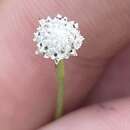Comments
provided by eFloras
Eriocaulon lineare closely resembles E. texanum, although it has paler bracts and flowers and a glabrous (rather than pilose) receptacle. Eriocaulon lineare blooms later and is most common in the margins or shallows of ponds, rather than in the sphagnous bogs favored by E. texanum.
- license
- cc-by-nc-sa-3.0
- copyright
- Missouri Botanical Garden, 4344 Shaw Boulevard, St. Louis, MO, 63110 USA
Description
provided by eFloras
Herbs, perennial, 6--20 cm (--80 cm when submersed). Leaves linear-attenuate, 1--10 cm (--20 cm when submersed), apex filiform. Inflorescences: scape sheaths mostly shorter than leaves in emergents, exceeding them in drier sites; scapes linear, 1 mm wide, 4--7-ribbed; heads (young or mature) very pale, hemispheric to nearly globose, rarely short-cylindric, 4--10 mm wide, soft, flattened when pressed; receptacle glabrous; involucral bracts sometimes squarrose, obscured by reflexed bracteoles and flowers of mature heads, straw-colored, orbiculate to ovate, 2--2.5 mm, margins entire, apex rounded, with white, club-shaped hairs; receptacular bracts and bracteoles pale except for grayish midzone, obovate to cuneate, 2 mm, margins entire, apex acute, ciliate, distal abaxial surfaces with white, club-shaped hairs. Staminate flowers: sepals 2, grayish, oblong-linear, curvate, 1.5--2 mm, apex acute with white, club-shaped hairs; androphore club-shaped; petals 2, pale, triangular, 0.5 mm, ciliate, hairs club-shaped; stamens 4; anthers black. Pistillate flowers: sepals 2, basally pale, darkening distally to grayish, gray-green, or gray-brown, narrowly oblong-obovate, curved, 2 mm, apex rounded, abaxially with white, club-shaped hairs; petals 2, yellow-white, broadly spatulate, flat, 1.5--2 mm, apex rounded, abaxially with white hairs, adaxially with white or clear hairs; pistil 2-carpellate. Seeds dark red-brown, ovoid or ellipsoid, 0.5--0.75 mm, faintly rectangular-reticulate, often papillate in lines.
- license
- cc-by-nc-sa-3.0
- copyright
- Missouri Botanical Garden, 4344 Shaw Boulevard, St. Louis, MO, 63110 USA
Distribution
provided by eFloras
Ala., Fla., Ga., N.C.
- license
- cc-by-nc-sa-3.0
- copyright
- Missouri Botanical Garden, 4344 Shaw Boulevard, St. Louis, MO, 63110 USA
Flowering/Fruiting
provided by eFloras
Flowering mostly summer--fall.
- license
- cc-by-nc-sa-3.0
- copyright
- Missouri Botanical Garden, 4344 Shaw Boulevard, St. Louis, MO, 63110 USA
Habitat
provided by eFloras
Sandy or peaty shores, hypericum ponds, wet savanna, southern coastal plain terraces; 0--100m.
- license
- cc-by-nc-sa-3.0
- copyright
- Missouri Botanical Garden, 4344 Shaw Boulevard, St. Louis, MO, 63110 USA
Comprehensive Description
provided by North American Flora
Eriocaulon lineare Small, Fl. SE. U. S. 236, 1328. 1903
Plants monoecious; stems very short; leaves very thin and pellucid, erect or recurved. 1.3-5 cm. long, 1-2 mm. wide at the middle (in deep water often elongate to 29 cm. and to 4 mm. wide), long-attenuate at apex, fenestrately 3-5-nerved (the fenestrations conspicuous), sparingly pubescent or subglabrate; peduncles deep-green, 3.5-30 cm. long, about 1 mm. in diameter (in deep water elongate to 63 cm. and to 5 mm. wide), 4-7-costate, often compressed in drying, frequently merely several-striate and fenestrate, obscurely twisted; sheaths equaling or surpassing the leaves (except in submerged plants), 1-7.5 cm. long (to 18 cm. long in deep water); heads depressed-hemispheric or subglobose, 5—10 mm. in diameter, whitevillose; involucral bractlets subhyaline or scarious, puberulent toward apex, the inner ones rhombic and acute, the outer ones subrotund; receptacle glabrous; receptacular bractlets hyaline below, dark-gray toward apex, spatulate or cuneate, subnavicular, acuminate, pilose toward apex; staminate florets: sepals 2, free, hyaline below, dark-gray toward apex, obovate or spatulate, navicular, acute, narrowly carinate-winged, sparsely pilose toward apex; petal-tube white, its lobes 2, small, linear, slightly unequal, glanduliferous within at apex, ciliate at apex; pistillate florets: sepals 2, hyaline at base, gray toward apex, broadly spatulate, navicular, acute, pilose at apex, with a subhyaline wing wider than that on the staminate florets; petals 2, free, linear, glanduliferous at apex within, pilose on both surfaces at apex, style about as long as or shorter than the ovary; stigmas 2, about as long as the ovary.
Type locality: Wet woods, Eocene geologic formation, overlaid by Lafayette and Columbia, Bullock County, Georgia (R. M. Harper 830).
Distribution: Wet woods and moist pinelands on the Coastal Plain from North Carolina to Florida and Alabama.
- bibliographic citation
- Albert Charles Smith, Harold Norman Moldenke, Edward Johnston Alexander. 1937. XYRIDALES. North American flora. vol 19(1). New York Botanical Garden, New York, NY

